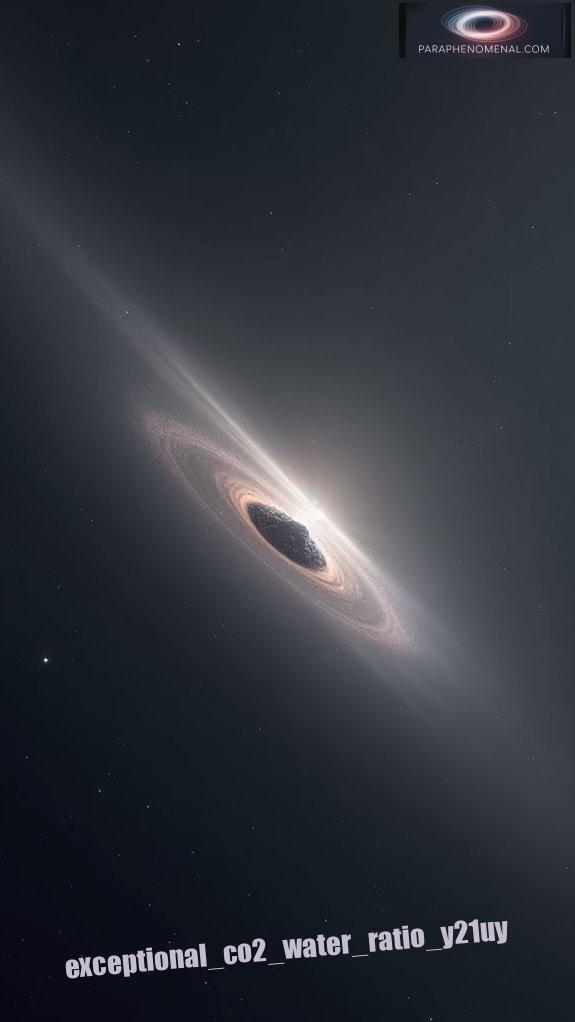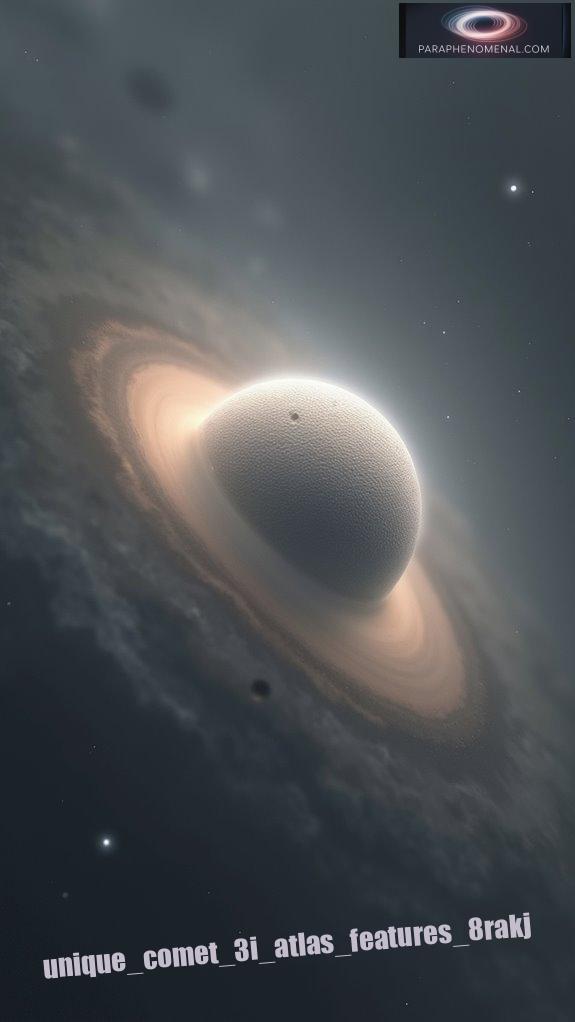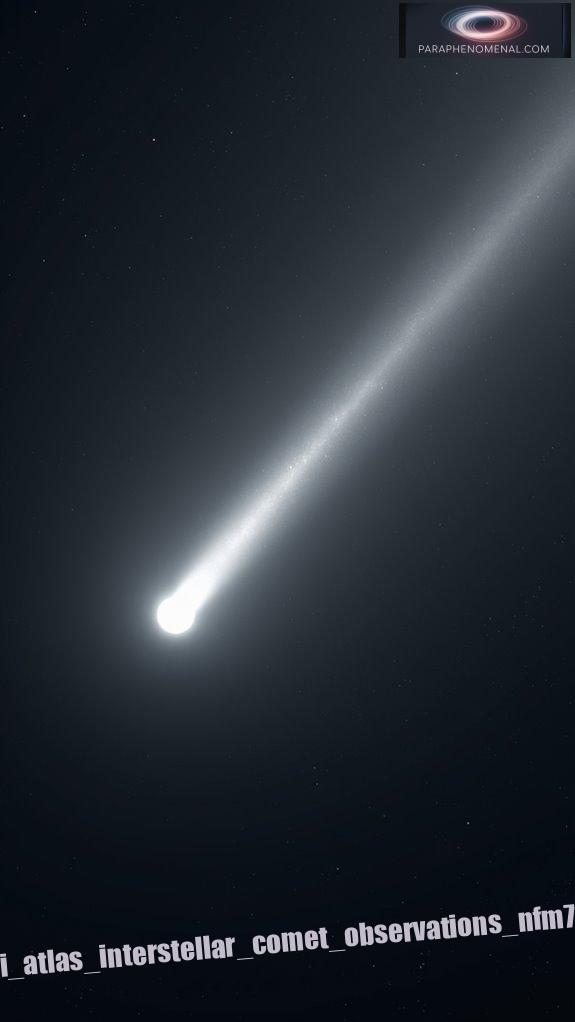Have you ever gazed up at the night sky and wondered what secrets lie beyond our planet?
The James Webb Space Telescope recently unveiled a stunning revelation about comet 3I/ATLAS.
It has an extraordinary CO2-to-water mixing ratio of approximately 8.0 ± 1.0, one of the highest ever recorded.
This rare composition suggests formation under unique conditions, possibly near the elusive CO2 frost line.
Can you imagine what that means?
The comet’s dust predominantly consists of carbon dioxide ice with just a hint of water ice.
These findings challenge our understanding of comet chemistry and hint at origins that might even stretch beyond our solar system. Exciting, isn’t it?
Unveiling Secrets of the Sky: A Captivating Encounter
A few years back, I went camping in the desert, far from city lights. I had the chance to stargaze, and as I lay there, I felt a sense of connection to the universe.
That night, the Milky Way was vivid, and I spotted a streak across the sky. Could it have been a comet?
The thought of celestial bodies swirling out there, with mysteries like those of 3I/ATLAS, filled me with awe.
I realized then how we continue to uncover cosmic secrets through modern science, unraveling the tales of ice and gas that travel through time and space.
UFO activity, comets, and astrological wonders—what truly lies out there waiting to be discovered?
Quick Takeaways
- James Webb Space Telescope identified a CO2-to-water mixing ratio of 8.0 ± 1.0 in comet 3I/ATLAS, the highest recorded in any comet.
- The dust composition of 3I/ATLAS consists of 95% carbon dioxide ice and 5% water ice, differing significantly from typical comet compositions.
- Spectral analysis revealed a gas composition of 85% carbon dioxide, challenging existing trends in comet studies regarding volatile ratios.
- High CO2 levels suggest unique formation conditions near the CO2 frost line, likely influenced by the comet’s interstellar origins.
- Observations coincided with the comet’s perihelion approach, enhancing visibility and data collection capabilities from multiple telescopes.
CO2-to-Water Mixing Ratio Observations

The high CO2 presence doesn’t just stand out statistically; it also challenges existing trends in comet studies.
3I/ATLAS shows an exceptional CO2-to-water mixing ratio of about 8.0 ± 1.0, one of the highest ever recorded in a comet. This value is a striking 6 to 6.1 standard deviations above typical ratios, turning heads in scientific circles.
The comet’s ratio defies the usual CO2 variability trends, where CO2 levels typically rise with distance from the Sun but rarely reach such heights so close in. Such high CO2 levels suggest unique cometary formation conditions, possibly tied to its origins near the CO2 frost line. This finding prompts further exploration into how comets like 3I/ATLAS deviate from the expected norm. Notably, the presence of water vapor was detected on 30 July and 1 August 2025, indicating active outgassing processes that contribute to its unique composition.
Composition of Dust and Gases
Observations of the coma surrounding comet 3I/ATLAS reveal a remarkable composition of dust and gases. The dust is primarily carbon dioxide ice, making up about 95%, with water ice contributing a mere 5%. This unusual dust composition makes 3I/ATLAS stand out among other comets, where water usually dominates. Recent findings highlight that the CO2 to water ratio is the highest ever seen in a comet.
The gas composition is even more intriguing, showing a high carbon dioxide presence, with an 8:1 CO2-to-water vapor ratio. Key components are summarized in the table below:
| Component | Dust Composition | Gas Composition |
|---|---|---|
| Carbon Dioxide (CO2) | 95% | 85% |
| Water Ice | 5% | 10% |
| Carbon Monoxide (CO) | N/A | 4% |
| Carbonyl Sulfide (OCS) | N/A | 1% |
These gas interactions and cometary dust variations suggest 3I/ATLAS’s unique interstellar origins.
Unique Features of 3I/ATLAS Nucleus

Unique features of the 3I/ATLAS nucleus reveal much about this intriguing comet.
The nucleus morphology hints at a teardrop shape, affecting dust dynamics in its vicinity. A rotation period of about 16.16 hours influences the distribution of gas and dust, creating an asymmetric coma. Additionally, high dust activity suggests that the comet may have undergone significant changes in its volatile compounds, further impacting its behavior. Recent studies indicate that its trajectory may also show similarities with interstellar visitors, indicating a potential link to other celestial bodies.
Large dust grains dominate near the nucleus, causing the absence of a visible tail, while the low dust production rate adds to its unusual behavior. The thick outer crust, altered by cosmic rays over billions of years, influences the retention of volatile compounds. Unique elemental emissions, including atomic nickel, showcase its distinctive surface characteristics.
Here at ParaPhenomenal, we aim to explore such enchanting phenomena, enhancing your understanding of celestial wonders like 3I/ATLAS.
Hypotheses for High CO2 Abundance
As scientists explore the mysteries surrounding 3I/ATLAS, several hypotheses emerge to explain its remarkably high abundance of carbon dioxide (CO₂).
One idea is that the comet’s nucleus contains CO₂ ice, frozen in greater amounts than water ice due to its formation near the CO₂ frost line. Additionally, this interstellar comet is believed to have formed under conditions distinctly different from those in our solar system, likely influencing its coma dynamics.
Another hypothesis points to intense cosmic radiation converting carbon monoxide (CO) to CO₂ over billions of years, creating a distinct irradiated crust.
There’s also the possibility that 3I/ATLAS originated in a carbon dioxide-rich parent star system, leading to unusual volatile ratios.
Finally, an insulating crust might limit water sublimation, allowing for enhanced CO₂ release.
Each of these CO₂ sources contributes to our understanding of ice formation and the unique nature of this interstellar comet.
Observational Context of the Findings

The intriguing findings about 3I/ATLAS come from a well-coordinated observational effort, which showcases the complex interplay between this interstellar comet and its solar environment.
- The comet’s journey began with its discovery on July 1, 2025.
- James Webb Space Telescope (JWST) conducted detailed spectral analysis on August 6, 2025.
- Observations coincided with the comet’s perihelion approach, enhancing its visibility.
- Other telescopes, like Hubble and SPHEREx, synchronized their observations for thorough data.
- The unique chemistry of 3I/ATLAS marks a significant finding, differing from previous interstellar objects.
- Previous NASA missions to study interstellar objects have paved the way for these insights into 3I/ATLAS.
All these elements combined provide you with a rich backdrop for understanding how 3I/ATLAS interacts with its environment and highlights its exceptional characteristics as an interstellar object.
Implications for Future Research and Observations
Understanding the chemical composition of 3I/ATLAS paves the way for exciting future research and observations.
With JWST’s findings on CO2 enrichment, you should anticipate focused studies on how radiation effects from cosmic rays alter interstellar chemistry. Observing more interstellar comets may reveal whether this CO2 enrichment is common among objects exposed to such long-term radiation.
By comparing interstellar visitors, like 2I/Borisov and ‘Oumuamua, you could discover universal chemical signatures influenced by their travel through space.
Future missions should target similar anomalies and utilize advanced telescopes for better chemical mapping.
Together, these efforts will deepen our understanding of how exposure to cosmic rays shapes the volatile compounds found in interstellar bodies, and may redefine our knowledge of organic molecule delivery to planets.
FAQ
How Does 3i/Atlas Compare to Other Comets in the Solar System?
3I/ATLAS stands out due to its unique comet composition, showcasing high carbon dioxide and nickel levels uncommon in solar system comets. Its unusual chemical profile suggests a distinct origin and evolutionary journey beyond our solar system.
What Instruments Did JWST Use to Analyze 3i/Atlas?
You’ll discover that JWST used the Near-Infrared Spectrograph for its spectroscopic analysis of 3I/ATLAS. This instrument captured infrared measurements, revealing vital details about the comet’s composition and offering glimpses beyond our usual cosmic understanding.
How Far Is 3i/Atlas From Earth Currently?
3I/ATLAS is currently about 337,814,248 kilometers from Earth. For celestial navigation enthusiasts like you, this distance emphasizes the beauty of our cosmos and the vastness awaiting your exploration. Keep your eyes on the skies!
What Is the Significance of High Nickel Abundance in Comets?
High nickel abundance in comets reveals crucial perspectives about comet evolution, suggesting diverse formation pathways and conditions. This nickel significance could help you understand early solar system processes and the delivery of metals to terrestrial planets.
When Will 3i/Atlas Reach Its Closest Approach to the Sun?
3I/ATLAS will reach its upcoming perihelion around October 30, 2025. As it follows a hyperbolic comet trajectory, this remarkable event offers a unique chance to observe its characteristics before it exits our solar system.
References
- https://en.wikipedia.org/wiki/3I/ATLAS
- https://www.smithsonianmag.com/science-nature/telescopes-reveal-surprising-chemistry-of-a-rare-interstellar-object-passing-through-our-solar-system-180987262/
- https://www.nextbigfuture.com/2025/08/interstellar-3i-atlas-has-nickel-without-iron-and-other-chemical-makeup-that-is-unlike-natural-objects-in-the-solar-system.html
- https://science.nasa.gov/missions/hubble/as-nasa-missions-study-interstellar-comet-hubble-makes-size-estimate/
- https://www.livescience.com/space/comets/james-webb-telescope-images-reveal-theres-something-strange-with-interstellar-comet-3i-atlas
- https://ntrs.nasa.gov/api/citations/20250009140/downloads/JWSTISO1.pdf
- https://www.universetoday.com/articles/3iatlass-coma-is-largely-carbon-dioxide
- https://astrobiology.com/2025/08/jwst-detection-of-a-carbon-dioxide-dominated-gas-coma-surrounding-interstellar-object-3i-atlas.html
- https://arxiv.org/abs/2508.18209
- https://www.foxweather.com/earth-space/webb-space-telescope-unusual-chemical-interstellar-comet-3i-atlas
- https://www.spectroscopyonline.com/view/interstellar-comet-3i-atlas-shows-mysterious-spectroscopic-activity
- https://www.iflscience.com/anti-tail-and-odd-594-kilometer-feature-found-on-interstellar-object-3iatlas-by-keck-observatory-81188
- https://www.livescience.com/space/comets/comet-3i-atlas-has-been-transformed-by-billions-of-years-of-space-radiation-james-webb-space-telescope-observations-reveal
- https://economictimes.com/news/international/us/3i/atlas-on-its-way-to-sun-should-we-be-worried-as-harvard-astronomer-says-40-chance-interstellar-comet-is-alien-technology-nasa-esa-nasa-and-esa-danger-to-earth-interstellar-object-hyperbolic-orbital-path/articleshow/124846772.cms
- https://www.space.com/astronomy/comets/interstellar-invader-comet-3i-atlas-is-still-full-of-surprises-an-unexpected-brightening-has-scientists-baffled
- https://science.nasa.gov/solar-system/comets/3i-atlas/
- https://science.gsfc.nasa.gov/600/nuggets/nugget-uploads/09_22_2025/09222025-nugget.pdf
- https://cosmicpursuits.com/3880/a-visitor-from-beyond-comet-3i-atlas-rounds-the-sun/
- https://www.space.com/astronomy/james-webb-space-telescope-takes-1st-look-at-interstellar-comet-3i-atlas-with-unexpected-results
- https://science.nasa.gov/blogs/3iatlas/2025/08/25/nasas-webb-space-telescope-observes-interstellar-comet/
- https://economictimes.com/news/international/us/did-you-miss-the-deep-crust-barely-visible-from-earth-in-3i/atlas-new-findings-reveal-strange-cause-for-it/articleshow/125050695.cms
- https://www.spectroscopyonline.com/view/3i-atlas-an-interstellar-enigma-natural-comet-or-engineered-probe-
- https://news.northeastern.edu/2025/09/08/3i-atlas-comet-interstellar-traveler/
- https://www.skyatnightmagazine.com/news/3i-atlas-neil-gehrels-swift-water-detection
- https://theskylive.com/how-far-is-c2025n1
- https://economictimes.com/news/international/us/3i/atlas-interstellar-object-turns-blue-near-sun-october-29-observations-anomalies-and-upcoming-earth-approach/articleshow/124955926.cms
